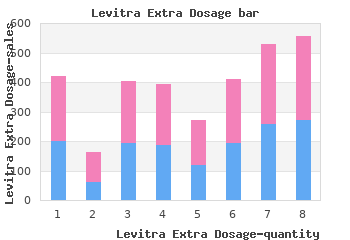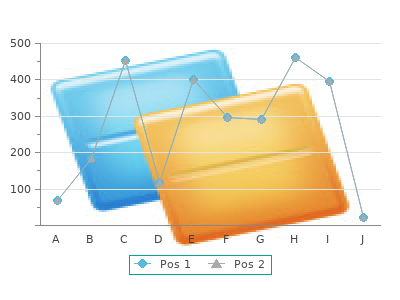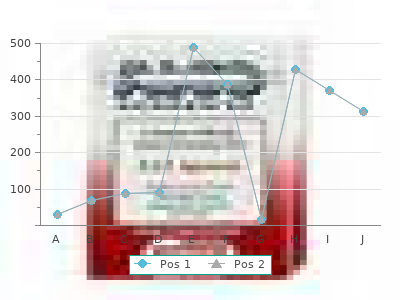Levitra Extra Dosage
By T. Brontobb. Art Institute of Ft Lauderdale.
When looking at aims and means of intervention cheap levitra extra dosage 40mg on-line, one decisive feature of the new administrative regulation is 11 Jean-Paul Gaudillière and Volker Hess its focus on both safety and effcacy purchase levitra extra dosage 40mg overnight delivery. In the name of public health agencies and governmental bodies have been granted the power to accept or deny marketing permits not only on the basis of pharmacological considerations about side-effects and therapeutic dangers but as well on the basis of suffcient or insuffcient statistical evaluation of clinical utility. This move has been interpreted either as the consequence of a new but fragile alliance between elite physicians and public health administrators suspicious of the growing infuence of the industry on medical practices or as the consequence of political pressures and lobbying within the context of enlarged access and gradual generalization (in Western industrialized societies) of encompassing health insurance systems. What is much less investigated are however: a) the role of other means of administrative intervention like labeling, practice guidelines, patient information or medical reporting; b) the limited infuence of this administrative regulation, its interplay with the industrial regulation in particular. The last way of regulating explored in this volume is the late 20th century public regulation, which is associated with the new roles of individuals alternatively taken as patients, users or consumers have taken upon themselves either in isolation or as members of civil society organizations and/or social movements. It was also prompted by pharmaceutical companies’ interest in having a more direct access to users, particularly potential consumers of disease-prevention drugs. Emphasis is therefore placed on quality of “service” and on the individual’s possibility of making (truly) informed choices. Major attention is given to the risks and potential iatrogenic effects of medical interventions, with observational epidemiology analysis of routine medical practices as well as risk-beneft analysis at the center. Regulatory tools do not only include administratively organized post-marketing surveillance, but also the precedents set by court decisions, or media campaigns, which may infuence regulatory authorities, physicians’ prescriptions or users’ choices. The rise of public regulation is an aspect of a broader politics of consumption that links empowerment to the need for consumers to organize in order to balance the power of industrial monopolies and gain infuence in a regulatory arena increasingly organized around “stake-holders” and their collective bargaining of interests. Within this context, expertise is “public” in the sense that it is often framed in terms of risk assessment conducted in “public spaces”, i. As a sign of its mounting infuence, other actors in the regulatory system, from administrative agencies to industrial frms, have adapted to this public way of regulating, for instance giving greater importance to the management of information. By focusing on a large range of practices associated with the trajectories of specifc drugs, the studies presented during the workshop document the four ways of regulating each in their own specifc manner, their strength is however to highlight on the one hand the peculiar assemblage of actors, values, forms of evidence and tool of intervention that characterize each way of regulating and - on the other hand – the historical and mutual construction of these four ways. Even if the so-called “double bind” namely the double imperative of facilitating innovation and enforcing safety remains a major feature of this administrative regulation the problems here are broader, stressing both the 19th century roots of this way of regulating and its interplay with the others. Within the chronological perspective outlined above the mounting importance of the administrative regulation has for instance been correlated with the declining infuence of the profession.

The advice and strategies contained herein may not be suitable for your situation cheap levitra extra dosage 40 mg without a prescription. Neither the publisher nor author shall be liable for any loss of proft or any other commercial damages levitra extra dosage 60 mg for sale, including but not limited to special, incidental, consequential, or other damages. For general information on our other products and services or for technical support, please contact our Customer Care Department within the United States at (800) 762-2974, outside the United States at (317) 572-3993 or fax (317) 572-4002. Library of Congress Cataloging-in-Publication Data: Peptide Chemistry and Drug Design / edited by Ben M. Summary: “This book details many of the problems and successes of peptides as potential drugs”– Provided by publisher. One additional infuence was a meeting in Dubai, where I had an excellent dinner with Waleed Danho, then with Roche Nutley. Waleed had given an excellent talk about the value of peptide chemistry and peptides as elements in the drug-discovery process. Over a delicious dinner of baked fsh and many other courses, we discussed the history of drug discovery and the role that peptides have played in the past. Waleed made the strong point that peptides still have great value in the discovery process and, with appropriate methods to deal with delivery and metabolism issues, can provide excellent drugs for the future. At around this time, I was contacted by Jonathan Rose of John Wiley & Sons who asked if I would be interested in editing a book on peptides and drug discovery. Sometimes life provides a nice juxtaposition of ideas and I immediately accepted the invitation. Over the following years, I spoke with many scientists, emailed some more, and worked on putting together the chapters for this book. I want to thank Jonathan as well as Kari Capone of John Wiley for their patience and advice over the years it took to bring this together. The book starts with a chapter provided by Nader Fatouhi, discussing the current state of peptides in drug discovery. I heard Nader speak at the 23rd American Peptide Symposium in the Kona region of the Big Island of Hawaii.

However buy levitra extra dosage 60 mg low price, testing and test the effectiveness of the drug will take years and will cost hundreds of millions of dollars 60 mg levitra extra dosage free shipping. Karazin Kharkiv National University, Kharkiv, Ukraine ** Institute for Molecular Biosciences, The Univercity of Queensland, Brisbane, Australia povstenko@gmail. The search for new and effective antimicrobial agents is an important task of medical chemistry because of the growth of pathogens drug resistance. Hence it is necessary to check antimicrobial activity of new synthesized compounds. The aim of present study is to conduct primary antimicrobial screening of new [1,2,4]triazolo[4,3-a]quinazolin-5(4H)-one derivatives containing amide group attached by carbon or sulfur – carbon chain. The set of 169 new [1,2,4]triazolo[4,3-a]quinazolin- 5(4H)-one derivatives containing amide group attached by carbon or sulfur – carbon chain has been tested for activity against 5 bacteria: Escherihia coli, Klebsiella pneumoniae, Acinetobacter baumannii, Pseudomonas aeruginosa and Staphylococcus aureus, and 2 fungi: Candida albicans and Cryptococcus neoformans. The resultant mid-log phase cultures was added to each well of the compound containing plates, giving a. Inhibition of bacterial growth was determined by measuring absorbance at 600 nm using a Tecan M1000 Pro monochromator plate reader. Then, 45 μL of the fungi suspension was added to each well of the compound-containing plates. Colistin and Vancomycin were used as positive bacterial inhibitor standards for Gramnegative and Grampositive bacteria, respectively. Fluconazole was used as a positive fungal inhibitor standard for Candida albicans and Cryptococcus neoformans. Several new [1,2,4]triazolo[4,3-a]quinazolin-5(4H)-one derivatives containing amide group attached by carbon or sulfur – carbon chain possess antimicrobial activity against Acinetobacter baumannii and fungi Cryptococcus neoformans. High-quality drinking water in an amount to meet basic human needs, is one of the conditions for strengthening human health and the sustainable development of the state as a whole. Failure to comply with the standard of drinking water quality will lead to adverse both short and long-term consequences for the health and welfare of the population. Two thirds of Ukrainians consume water from rivers, lakes and reservoirs, and one-third - get water from underground sources.

Haemopoietic System: Neutropaenia quality levitra extra dosage 40mg, leukopaenia buy 60mg levitra extra dosage otc, thrombocytopaenia, thrombocythaemia, eosinophilia. Skin: Skin rash Gastrointestinal System: Diarrhoea, oral candidiasis (oral thrush), vomiting, nausea, stomach cramps, anorexia and pseudomembranous colitis. Several cephalosporins have been implicated in triggering seizures, paticularly in patients with renal impairment when the dosage was not reduced. For doses not equalling vial size, prepare the solutions as follows: Vial size 500mg 1gm 2gm Volume of diluent 10ml 10ml 10ml Volume of final solution 10. Cefotaxime sodium has a high degree of stability in the presence of beta-lactamases, both penicillinases and cephalosporinases, of gram- negative and gram-positive bacteria. Cefotaxime has been shown to be active against most strains of the following microorganisms both in vitro and in clinical infections: Aerobes, Gram-Positive: Enterococcus spp. Therefore, it is important to consider this diagnosis in patients who present with diarrhoea subsequent to the administration of antibacterial agents. Agranulocytosis As with other beta-lactam antibiotics, granulocytopaenia and, more rarely, agranulocytosis may develop during treatment with cefotaxime sodium, particularly if given over long periods. Haematologic System: Neutropaenia, transient leukopaenia, eosinophilia, thrombocytopaenia and agranulocytosis have been reported. Some individuals have developed positive direct Coombs Tests during treatment with cefotaxime sodium and other cephalosporin antibiotics. Kidney: As with some other cephalosporins, interstitial nephritis and transient elevations of creatinine have been occasionally observed with cefotaxime sodium. Cutaneous: As with other cephalosporins, isolated cases of erythema multiforme, Stevens-Johnson syndrome, and toxic epidermal necrolysis have been reported. Several cephalosporins have been implicated in triggering seizures, paticularly in patients with renal impairment when the dosage was not reduced.
The term can be used generally with reference to the whole range of Psychoactive drugs (drug dependence buy levitra extra dosage 40mg overnight delivery, chemical dependence buy levitra extra dosage 60 mg low cost, substance use dependence), or with specific reference to a particular drug or class of drugs (eg opioid dependence). In biologically oriented discussion, dependence is often used to refer only to physical dependence. Dependence or physical dependence is also used in the Psychopharmacological context in a still narrower sense, referring solely to the development of withdrawal symptoms on cessation of drug use. Dependence potential is determined by those intrinsic pharmacological properties that can be measured in animal and human Drug-testing procedures. Dependence syndrome A cluster of behavioural, cognitive, and physiological phenomena that may develop after repeated Substance use. Typically, these phenomena include a strong desire to take the Drug, impaired control over its use, persistent use despite harmful consequences, a higher priority given to drug use than to other activities and obligations, increased Tolerance, and a physical withdrawal reaction when Drug use is discontinued (Withdrawal syndrome). Dependence syndrome may relate to a specific substance (eg heroin), a class of substances (eg opioids), or a wider range of pharmacologically different substances. Detoxification A controlled process of providing symptomatic relief to assist patients to complete withdrawal from a Drug, while minimising the associated adverse effects. In the context of Illicit drug use, the aim of detoxification is to reverse or reduce Dependence on and Tolerance to a Psychoactive drug. Diversion From a medical perspective, diversion is the inappropriate use of a Drug by those for whom it has been prescribed, or use by a person for whom the medication was not prescribed. The term may be used to describe diversion of a shipment of drugs out of legal channels at wholesale level or, for example, to describe the sale of prescription methadone to, and use by, an individual for whom it was not prescribed. The term diversion is also used in a criminal justice context to refer to measures that take an arrestee out of the criminal justice system and into education, medical management or another type of intervention. In medicine, it refers to any substance with the potential to prevent or cure disease or enhance physical or mental welfare, and in pharmacology it refers to any chemical agent that alters the biochemical or physiological processes of tissues or organisms. In common usage, the term often refers specifically to Psychoactive drugs, and often, even more specifically, to Illicit drugs, of which there is non-medical use in addition to any medical use. Professional formulations (eg ‘alcohol and other drugs’) often seek to make the point that caffeine, tobacco, alcohol and other substances in common non-medical use are also drugs in the sense of being taken, at least in part, for their psychoactive effects. In other contexts, abuse has referred to non-medical or unsanctioned patterns of use, irrespective of consequences. Drug control The regulation, by a system of laws and agencies, of the production, distribution, sale and use of specific Psychoactive drugs (Controlled substances) locally, nationally or internationally.

It is rather a heuristic model order levitra extra dosage 60mg otc, focusing on the dynamics of social action generic levitra extra dosage 40mg fast delivery, useful to bring some order in the multiplicity of regulatory practices mentioned above. The notion of ways of regulating seeks to bring to light the inner logic of specifc combination of practices and procedures, describing the various rationalities implicated in the management of therapeutic agents. The approach therefore link the peculiar social worlds involved in regulation, the forms of evidence and expertise they mobilized and the means of intervention they choose or establish. Like Pickstone’s ways of knowing ways of regulating are historical products: they have not existed in all eternity, they appeared at some point in history, none ever disappeared but their arrangements and articulation have been utterly variable. Ways of regulating are therefore categories or frames used in thinking about, choosing between and organizing practices that are not “given” but constructed in a given situation, each represent a “grammar of action” that operate in combination rather than in isolation. The dynamics of a peculiar form of regulation should therefore be discussed at different levels, taking into account the following questions: which values guide the regulation process? Given these entries, we make the proposal that drug regulation, in a long 20th century beginning in the 1870s, can been characterized by the gradual emergence of four ways of regulating. As previously outlined, the professional regulation of drugs originates in the 19th century corporative organization of pharmacy. In continental Europe, it evolved out of a state delegation of expertise, which granted graduated pharmacists with a monopoly over the sales and the preparation of the therapeutic agents included in the national pharmacopoeia. Such regulation was justifed as a means to avoid unnecessary competition among pharmacists as well as a means to eliminate the entry of supposedly untrained and unskilled practitioners on the market. Professional governance emanates from corporations, pharmaceutical societies and their medical counterparts, eventually supplemented with special committees of experts set up by academic journals or public health authorities. Within this confguration, the judgment about the value of specifc drugs focused on the production of pharmacological knowledge linking dosage, concentration within the body, pattern of elimination, and the balance between toxic and 10 Introduction therapeutic responses. In addition to the traditional pharmacopoeia, which defned regulatory tools include the many forms of guidelines and recommendations for practice issued by collectives of pharmacists and/or physicians. During the frst decades of the 0th century, this dynamics of professional regulation was less and less able to cope with the gradual transformation of many workshops into proper factories, with the development of industrial specialties, and with the growing competition between pharmaceutical frms and chemical corporations.
Any global governance process will need to focus on public health generic levitra extra dosage 60mg online, a goal all parties can support and come to consensus around buy levitra extra dosage 60 mg lowest price. Global governance includes hard law, such as treaties, and soft law, such as resolutions, declarations, memorandums of understanding, and codes of practice (Gostin, 2013). If countries or regions wish to negoti- ate a treaty on falsifed and substandard drugs, then they should do so, but international soft law may be a more practical short-term solution to the problem. A soft-law solution could encourage international momentum for drug regulation, surveillance, and law enforcement. It would also build trust among stakeholders and pave the way for a future hard-law solution if necessary. Two treaty processes already under way relate to the problem of substandard and falsifed medicines. The Council of Europe’s Medicrime Convention (offcially, “the Convention on the counterfeiting1 of medical products2 and similar crimes involving threats to public health”) is a multi- lateral treaty intended to prevent the public health threats of illegitimate medicines (Council of Europe, 2011). The convention aims to make crimes of drug adulteration and of the intentional manufacture, supply, or trade in illegitimate medicines or ingredients, and their accessories (Council of Europe, 2011). Other criminal offenses under Medicrime include tamper- ing with the drug pedigree or making false drug documents; putting an unauthorized drug on the market; and intentionally aiding or abetting a criminal in one of the named offenses (Council of Europe, 2011). Med- icrime also gives terms for protecting victims, including victim’s rights to compensation from perpetrators, and for international cooperation in investigation, extradition, and mutual legal assistance (Council of Europe, 2011). By December 2012, 22 countries had signed the convention, but only Ukraine had ratifed it (Council of Europe, 2012). Medicrime will not come into force until fve countries ratify it, including three Council of Europe members (Council of Europe, 2011). Critics of the convention see in Medicrime an attempt to treat routine 1 The Medicrime Convention defnes a counterfeit as a false representation of identity or source (Council of Europe, 2011).


